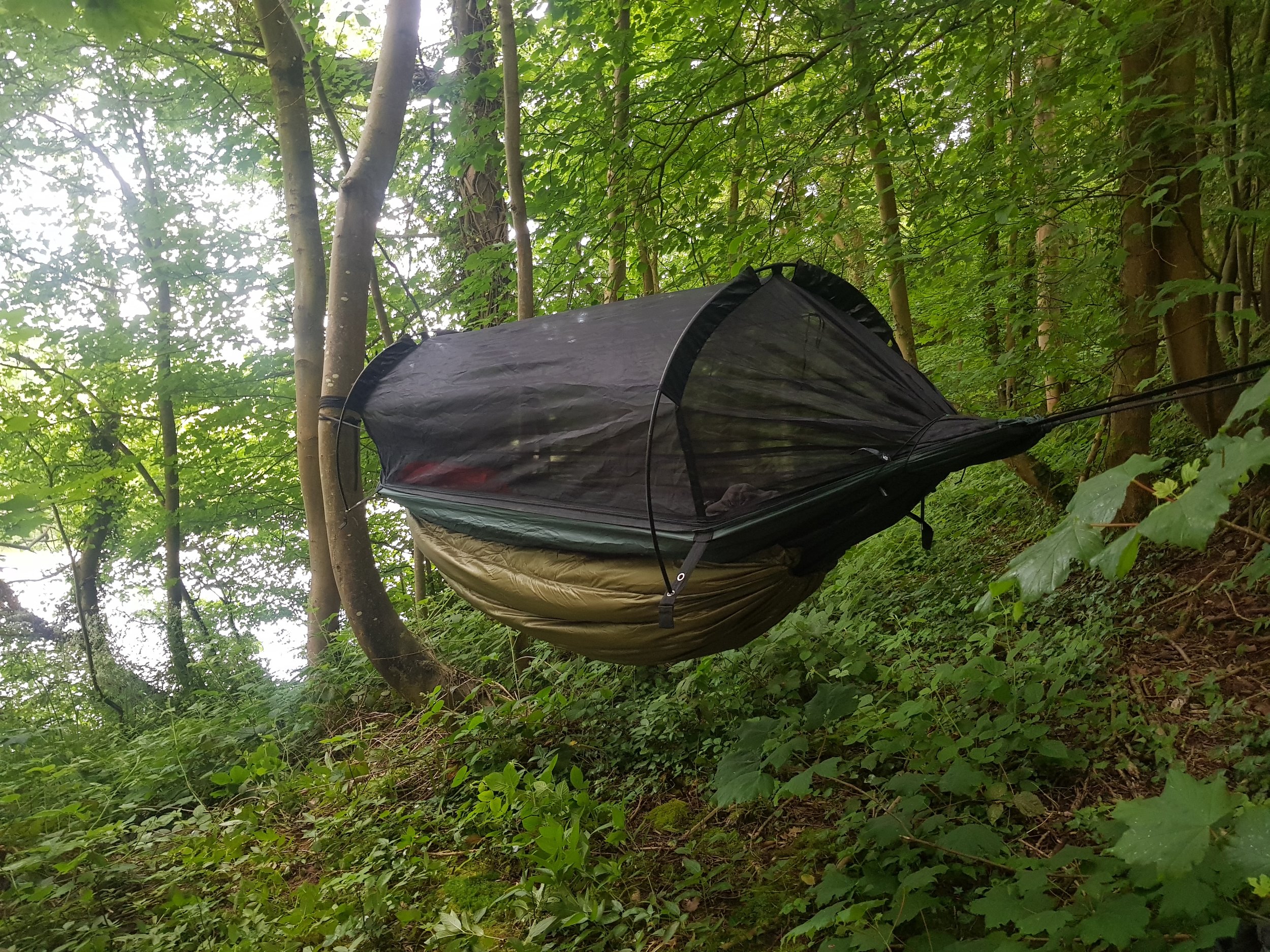Shelters
Tent, Tarp & Bivi, Hammock, Canvas?
My favourite thing to do is to go on a paddling camping trip and with the range of options for a shelter and sleep system I thought I’d write up a bit about each of the systems I use and the pros and cons of each. So many people envisage camping as your traditional two man tent in a field and expect the experience to be uncomfortable, damp and not cosy in the slightest and the thought of camping in the winter months is a no no.
Well, it doesn’t have to be like that and there are so many different options to experience camping in a new way. What inspired me to write this post was the fact that after going on expeditions with my partner and holidays that typically involve wild camping the assumption is made that we are roughing it and that I need to treat my other half to a luxury holiday in a resort to compensate. In fact this is the opposite to what we’d rather be doing, well at least I think it is!
So, what options are there?
Firstly, regardless of what type of shelter you are going to use it is essential to equip yourself with a good sleeping mat and sleeping bag. If you don’t have these right then you’re going to struggle to be warm and comfortable. This doesn’t need to be a huge expense, you can get a decent sleeping bag for around £50 and a good sleeping mat for about £60. Saying that, the more you spend the lighter and warmer the kit tends to be.
You tend to have two main types of insulation which are down and synthetic. I have a few different bags and mats, generally all being synthetic. Synthetics have the benefit of being warm even when wet. However, down is a lot lighter, packs down smaller but if it gets wet the feathers clump together which isn’t great for the kit. Synthetics are great for what I do as there’s a possibility of kit getting damp when on the water and weight isn’t too much of an issue when transported by boat.
The sleeping bag I tend to use for winter is a Snugpak Chrysalis 4 and in summer a Vango Planet 100. The sleeping mat I use all year round is a Exped Synmat HL Winter.
Once you’ve got a good bag and mat we can think about what we are going to sleep in/under.
TENTS
We’ll start with the tent. Obviously there are so many different types of tent, it has to be said I’m not a huge fan of tents, but they definitely have their place in my collection of kit. Its worth spending a bit of money on a decent tent and there are some amazing options out there from a big tipi style tent where you can have a woodburner inside like the Tentipi range, to a top of the range ultralight option like Hillenberg or MSR.
The reason i’m not a huge fan of tents is due to being removed from the outdoor once you’re inside. A big part of camping for me is to fall asleep looking at the stars or watching the fire and waking up to an amazing view. However this isn’t always practical especially with a lot of the work I do with youth groups, you need to have a bit more privacy which is why I bought a tent.
The tent I went for is a MSR Hubba NX1. This isn’t a cheap tent but there were many reasons I was drawn to it. Firstly I have been using MSR kit for some time and am always impressed with the quality of what they produce. Secondly, this tent is extremely light weighing just 1.29kg! This is great for me especially when flying abroad for an expedition when weight becomes a factor. This tent is so easy to put up with a singular pole system. The advantage of pitching up in minutes means I can focus on the groups that I am working with.
I have only used the MSR hubba once and am very pleased with it. The only downside to this tent is the fact that you have to pitch the inner first then the rain cover. So when arriving in the rain it wouldn’t be great. However I can overcome this by using an additional tarp.
BIVI & TARP
One of the other lightweight systems I use is a bivi bag and tarp. It’s extremely versatile and an option I am a fan of, however it’s not for those who feel claustrophobic. The bivi I use is a Snugpak Stratosphere and the tarps I use are from Nordisk and DD with the Nordisk being my preferred choice. The benefits of this system is how simple it is to put up and how light it is, however space to keep things dry and guaranteeing you will stay dry in a huge downpour makes a tarp over the top essential. When using a thick sleeping mat and a thick sleeping bag space is even more limited!
CANVAS
Another option I go for is similar to the option above but using a bivi and tarp made out of canvas. Camping under canvas is something I’ve always been drawn to inspired by Bill Mason and adventurers like Horace Kephart. The reason it took me so long to invest in canvas is due to the weight. It only becomes an option for me when I know I won’t be carrying it for long, driving to the site or transporting it by canoe.
The benefit of canvas is the fact it is flame retardant especially when it is treated. I give my kit some real abuse and it always terrifies me when i’m using ultralight kit in a demanding environment. I love how robust canvas kit is. With canvas you gain the feeling of being truly immersed in the outdoors and the advantage of being able to have the shelter close to the fire, gaining extra heat. There are so many options with this combination of kit especially when you start looking at the art of tarpology!
HAMMOCK
Now for one of my favourite systems, the hammock. Sleeping in a hammock tends to be thought of as a snooze in the back garden rather than a serious option for camping. However some consider hammocks to be the most comfortable choice.
Ever since working in the Ardèche and sleeping in a hammock three times a week for six months i’ve been converted to this option rather than a ground dweller. Once the hammock is set up correctly you don’t banana too much and sleeping diagonally helps too. It’s very comfortable and once you’re all tucked in you feel very cosy. As you can imagine there are a few factors to consider when choosing a hammock over a tent. Firstly you have to be pretty sure that there are going to be trees, I’ve made this mistake before and ended up hammocking using a canoe trailer, vehicles and even with a singular tree. Also the challenge of getting into your sleeping bag when in the hammock, this option once again is better suited to those who don’t suffer from claustrophobia. It can also prove a problem when you have to go to the loo in the night but generally these issues are outweighed by the comfort a decent hammock provides.
Certain places make a hammock preferable, for example where there is rough terrain or certain insects and animals you may want to keep away from.
There are multiple manufacturers of hammocks of varying quality and the two leading brands tend to be DD and Hennessy. The hammock I used in the Ardèche was a simple hammock made out of parachute material at the cost of about thirty euros. Ive since invested in a hammock from DD called the Frontine Hammock XL, which is great with its inbuilt mosquito net.
When using a hammock it is important to think about what is insulating the bottom of your hammock and a mistake which a lot of people make is solely using a sleeping bag. You can either use a sleeping mat or an under quilt. The issue with a sleeping mat is that they tend to slip out of place whereas an under quilt sits under the hammock and encompasses the bottom of the hammock. You can get a decent under quilt made from either synthetic or down.
WHELEN
Finally we get to my preferred method of camping which I was introduced to by Steve at Axe & Paddle Bushcraft, the Whelen shelter.
The Whelen was designed by Colonel Whelen who wasn’t a big fan of tents and wanted to design a shelter that allowed him to be as close to natural surroundings as was possible and that was practical.
The Whelen is essentially a canvas tarp that is sewn in a configuration that creates a canvas lean to. When using the Whelen you need to use a canvas bivi bag like we mentioned above.
The joy of the Whelen is the fact that you are completely immersed in your surroundings, watching the fire as you drift off and waking up to the view. The design of the Whelen allows the heat from the fire to be caught by the awning recirculating the heat into the shelter. I have slept in the Whelen comfortably in the coldest nights of the year and been toasty thanks to a good fire. It honestly feels like taking your living room into the outdoors.
The only downside to the Whelen is again the weight of canvas, Steve who makes these great shelters has started to experiment with using oil cloth to reduce the weight.
The Whelen has to be my go to option for camping when the location permits. When exploring the remote areas of Scotland it definitely enhances the whole experience. My Whelen was made by a company called The Red Tent Company you can visit their site here.
Axe & Paddle also make Whelen shelters and you can visit Steve and Kirsty’s website here!
For Tents, sleeping bags and sleeping mats visit Trekitt here
For Hammocks and tarps click here






